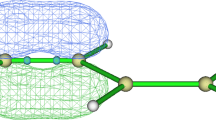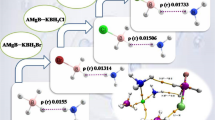Abstract
In this work, the nature of the chemical interactions between the metalloid atom (M = Si, Ge, As, Sb, Te, Po) and the nitrogen atoms in the bora-amidinate (bam) complexes (ClnM[PhB(NtBu)2]) are investigated, mainly via density-based indices. The descriptors used are derived using the quantum theory of atoms in molecules and natural orbitals for chemical valence approaches. It is shown that the strongest interaction is achieved with silicon. Indeed, it is generally the lightest metalloid in a particular group of the periodic table (i.e., Si, As, and Te for groups 14–16, respectively) that exhibits the strongest bond in the bam complex. This suggests that the atomic radius of the metalloid is a useful parameter for predicting the bonding strength. Extended transition state (ETS) decomposition results indicate that the interactions are more electrostatic than due to orbital interactions.







Similar content being viewed by others
References
Fedorchuk C, Copsey M, Chivers T (2007) The coordination chemistry of boraamidinate ligands. Coord Chem Rev 251:897–924
Baker RJ, Jones C, Junk PC, Kloth M (2004) Kinetic control over the thermal stability of the In–H bond: synthesis and characterization of amido indium hydride complexes. Angew Chem Int Ed 43:3852–3855
Abdou HE, Mohamed AA, Fackler JP (2007) Oxidative addition of small molecules to a dinuclear Au(I) amidinate complex, Au2[(2,6-Me2Ph)2N2CH]2. Syntheses and characterization of Au(II) amidinate complexes including one which possesses Au(II)−oxygen bonds. Inorg Chem 46:9692–9699
Jin G, Jones C, Junk P, Stasch A, Woodul WD (2008) Group 13 metal(I) and (II) guanidinate complexes: effect of ligand backbone on metal oxidation state and coordination sphere. New J Chem 32:835–842
Arndt S, Okuda J (2005) Cationic alkyl complexes of the rare-earth metals: synthesis, structure, and reactivity. Adv Synth Catal 347:339–354
Edelmann FT (2008) Advances in the coordination chemistry of amidinate and guanidinate ligands. Adv Organomet Chem 57:183–352
Skvortsov GG, Yakovenko MV, Fukin GK, Cherkasov AV, Trifonov AA (2007) Guanidinate borohydride derivatives of lanthanides: synthesis and molecular structures of the [(Me3Si)2NC(NCy)2]Gd(BH4)2DME and [{(Me3Si)2NC(NPri)2}2Sm(BH4)2]−[Li(DME)3]+ complexes. Catalytic activity of the [(Me3Si)2NC(NCy)2]2Ln(BH4)2Li(THF)2 complexes (Ln = Nd, Sm, or Yb) in methyl methacrylate polymerization. Russ Chem Bull 56:1742–1748
Chivers T, Eisler DJ, Fedorchuk C, Schatte G, Tuononen HM, Boere RT (2005) Stable spirocyclic neutral radicals: aluminium and gallium boraamidinates. Chem Commun 31:3930–3932
Chivers T, Fedorchuk C, Schatte G, Parvez M (2003) Syntheses and X-ray structures of monocyclic, bicyclic, and spirocyclic gallium and indium boraamidinates. Inorg Chem 42:2084–2093
Manke DR, Nocera DG (2006) Solid state aggregation of lithium and thallium(I) bis(alkylamido)phenylboranes. Polyhedron 25:493–498
Fusstetter H, Nöth H (1979) Beiträge zur Chemie des Bors, CIII. Über ein dimeres Diazastannaboretidin: Darstellung, dynamisches Verhalten und Molekülstruktur. Chem Ber 112:3672–3681
Heine A, Fest D, Stalke D, Habben CD, Meller A, Sheldrick GM (1990) Synthesis and X-ray crystal structure of a tricyclic lead–nitrogen–boron heterocycle. J Chem Soc Chem Commun 10:742–743
Fest D, Habben CD, Meller A, Sheldrick GM, Stalke D, Pauer F (1990) N,N′-Dilithiobis(alkylamino)phenylborane als Synthesebausteine für viergliedrige Metallacyclen. Chem Ber 123:703–706
Paetzold P, Hahnfeld D, Englert U, Wojnowski W, Dreczewski B, Pawelec Z, Walz L (1992) Addition von Silylenen an Iminoborane. Chem Ber 125:1073–1078
Habben CD, Heine A, Sheldrick GM, Stalke DZ (1992) Synthese und Kristallstruktur von 1,3-Di-tert-butyl-4,4-di-methyl-2-pentafluorphenyl-4,2-stannabora-cyclobutan. Naturforsch 47b:1367–1369
Geschwentner M, Noltemeyer M, Elter G, Meller AZ (1994) Metalla- und phosphaheterocyclen mit Diamino-Supermesitylboryl-Einheiten. Anorg Allg Chem 620:1403–1408
Luthin W, Stratman JG, Elter G, Meller A, Heine A, Gornitzka HZ (1995) Die 2,6-Diisopropyl-phenylgruppe als sperriger Substituent in Bor-Stickstoff-Verbindungen. Anorg Allg Chem 621:1995–2000
Albrecht T, Elter G, Noltemeyer M, Meller AZ (1998) Vier- und achtgliedrige metallhaltige Bor–Stickstoff-Heterocyclen. Bildung und Strukturen in Abhängigkeit von der Raumerfüllung der Substituenten. Anorg Allg Chem 624:1514–1518
Gudat D, Niecke E, Nieger M, Paetzold P (1988) Über die Reaktion von tert-butyl(tert-butylimino)phosphan mit tert-butyl-(tert-butylimino)boran. Chem Ber 121:565–568
Chivers T, Fedorchuk C, Schatte G, Brask JK (2002) Syntheses and X-ray structures of boraamidinate complexes of lithium, phosphorus, and tellurium. Can J Chem 80:821–831
Jari K, Maravanji SB, Tristram C, Thomas WS (2007) New bonding modes for boraamidinate ligands in heavy group 15 complexes: fluxional behavior of the 1:2 complexes, LiM[PhB(NtBu)2]2 (M = As, Sb, Bi). Inorg Chem 46:2627–2636
Habben CD, Heine A, Sheldrick GM, Stalke D, Bühl M, Schleyer PvR (1991) Synthese und Eigenschaften von 1,2,4,3-Thiadiazaboretidinen. Kristallstruktur des 2,4-Di-tert-butyl-3-phenyl-1,2,4,3-thiadiazaboretidins. Chem Ber 124:47–50
Habben CD, Herbst-Irmer R, Noltemeyer MZ (1991) Synthese und Kristallstruktur von 2,4-Di-tert-butyl-3-pentafluorphenyl-1,2,4,3-thiadiazaboretidin. Naturforsch 46b:625–628
Freitag B, Fischer CA, Penafiel J, Ballmann G, Elsen H, Färber C, Piesikb DF, Harder S (2017) Bora-amidinate as a cooperative ligand in group 2 metal catalysis. Dalton Trans 46:11192–11200
Mitoraj M, Michalak A (2007) Natural orbitals for chemical valence as descriptors of chemical bonding in transition metal complexes. J Mol Model 13:347–355
Mitoraj PM, Michalak A, Ziegler T (2009) A combined charge and energy decomposition scheme for bond analysis. J Chem Theory Comput 5:962–975
Morell C, Grand A, Toro-Labbé A (2005) New dual descriptor for chemical reactivity. J Phys Chem A 109:205–212
Morell C, Grand A, Toro-Labbé A (2006) Theoretical support for using the Δf(r) descriptor. Chem Phys Lett 425:342–346
te Velde G, Bickelhaupt FM, Baerends EJ, Fonseca Guerra C, Van Gisbergen SJA, Snijders JG, Ziegler T (2001) Chemistry with ADF. J Comput Chem 22:931–967
Fonseca Guerra C, Snijders JG, te Velde G, Baerends EJ (1998) Towards an order-N DFT method. Theor Chem Accounts 99:391–403 23
Baerends EJ, Ziegler T, Atkins AJ, Autschbach J, Baseggio O, Bashford D, Bérces A, Bickelhaupt FM, Bo C, Boerrigter PM, Cavallo L, Chong DP, Chulhai DV, Daul C, Deng L, Dickson RM, Ellis DE, van Faassen M, Fan L, Fischer TH, Fonseca Guerra C, Franchini M, Ghysels A, Giammona A, van Gisbergen SJA, Goez A, Götz AW, Groeneveld JA, Gritsenko OV, Grüning M, Gusarov S, Harris FE, van den Hoek P, Hu Z, Jacob CR, Jacobsen H, Jensen L, Joubert L, Kaminski JW, van Kessel G, König C, Kootstra F, Kovalenko A, Krykunov MV, van Lenthe E, McCormack DA, Michalak A, Mitoraj M, Morton SM, Neugebauer J, Nicu VP, Noodleman L, Osinga VP, Patchkovskii S, Pavanello M, Peeples CA, Philipsen PHT, Post D, Pye CC, Ramanantoanina H, Ramos P, Ravenek W, Rodríguez JI, Ros P, Rüger R, Schipper PRT, Schlüns D, van Schoot H, Schreckenbach G, Seldenthuis JS, Seth M, Snijders JG, Solà M, Stener M, Swart M, Swerhone D, Tognetti V, te Velde G, Vernooijs P, Versluis L, Visscher L, Visser O, Wang F, Wesolowski TA, van Wezenbeek EM, Wiesenekker G, Wolff SK, Woo TK, Yakovlev AL (2016) ADF2016. SCM, Vrije-Universiteit, Amsterdam. http://www.scm.com
Perdew JP, Burke K, Ernzerhof M (1996) Generalized gradient approximation made simple. Phys Rev Lett 77:3865–3868
Van Lenthe E, Ehlers A, Baerends EJ (1999) Geometry optimizations in the zero order regular approximation for relativistic effects. J Chem Phys 110:8943–8953
Ziegler T, Rauk A (1977) On the calculation of bonding energies by the Hartree Fock Slater method. Theor Chim Acta 46:1–10
Morokuma K (1971) Molecular orbital studies of hydrogen bonds. III. C=O···H–O hydrogen bond in H2CO···H2O and H2CO···2H2O. J Chem Phys 55:1236–1244
Ziegler T, Rauk A (1979) CO, CS, N2, PF3, and CNCH3 as σ donors and π acceptors. A theoretical study by the Hartree–Fock–Slater transition-state method. Inorg Chem 18:1755–1759
Michalak A, Mitoraj M, Ziegler T (2008) Bond orbitals from chemical valence theory. J Phys Chem A 112:1933–1939
Kohout M (2008) DGrid, version 4.3. M. Kohout, Radebeul
Bader RFW (1990) Atoms in molecules: a quantum theory. Clarendon, Oxford
Matta CF, Hernandez-Trujillo J, Tang TH, Bader RFW (2003) Hydrogen–hydrogen bonding: a stabilizing interaction in molecules and crystals. Chem Eur J 9:1940–1951
Grabowski SJ, Pfitzner A, Zabel M, Dubis AT, Palusiak M (2004) Intramolecular H···H interactions for the crystal structures of [4-((E)-but-1-enyl)-2,6-imethoxyphenyl]pyridine-3-carboxylate and [4-((E)-pent-1-enyl)-2,6-dimethoxyphenyl]pyridine-3-carboxylate; DFT calculations on modeled styrene derivatives. J Phys Chem B 108:1831–1837
Matta CF, Castillo N, Boyd RJ (2005) Characterization of a closed-shell fluorine−fluorine bonding interaction in aromatic compounds on the basis of the electron density. J Phys Chem A 109:3669–3681
Pendás AM, Francisco E, Blanco MA, Gatti C (2007) Bond paths as privileged exchange channels. Chem Eur J 13:9362–9371
Behera RN, Panda A (2012) Effect of chelate ring and rigidity on Se⋯N interactions: a computational study. RSC Adv 2:6948–6956
Baryshnikov GV, Minaev BF, Minaeva VA, Baryshnikova AT, Pittelkow M (2012) DFT and QTAIM study of the tetra-tert-butyltetraoxa[8]circulene regioisomers structure. J Mol Struct 1026:127–132
Nalewajski RF, Mrozek J, Michalak A (1997) Two-electron valence indices from the Kohn–Sham orbitals. Int J Quantum Chem 61:589–601
Mitoraj M, Michalak A, Ziegler T (2009) On the nature of the agostic bond between metal centers and β-hydrogen atoms in alkyl complexes. An analysis based on the extended transition state method and the natural orbitals for chemical valence scheme (ETS-NOCV). Organomet 28:3727–3733
Slater JC (1964) Atomic radii in crystals. J Chem Phys 41:3199–3205
Wells AF (1984) Structural inorganic chemistry. Oxford University Press, Oxford
Greenwood NN, Earnshaw A (1984) Chemistry of the elements. Pergamon, Oxford
Chermette H (1999) Chemical reactivity indexes in density functional theory. J Comput Chem 20:129–154
Biswas S, Pramanik A, Sarkar P (2017) Computational studies on the mechanism and selectivity of Al8O12 nanocluster for different elimination reactions. Struct Chem 28:1895–1906
Biswas S, Pramanik A, Sarkar (2016) Computational studies on the reactivity of alkyl halides over (Al2O3)n nanoclusters: an approach towards room temperature dehydrohalogenation. Nanoscale 8:10205
Acknowledgements
All the authors feel very honored to contribute to this special issue dedicated to Prof. Pratim K. Chattaraj, one of the pioneers of conceptual DFT. CM especially thanks Prof. Chattaraj for being a beacon in the field of conceptual DFT.
SL acknowledges financial support from the University of Oum el Bouaghi and The Algerian Ministry of Higher Education and Scientific Research. She also wishes to thank Professor Ouddai Nadia (Batna1 University), who contributed to the collaboration with Professor H. Chermette.
Author information
Authors and Affiliations
Corresponding author
Additional information
This paper is dedicated to Professor Pratim Kumar Chattaraj on the occasion of his 60th birthday.
This paper belongs to Topical Collection International Conference on Systems and Processes in Physics, Chemistry and Biology (ICSPPCB-2018) in honor of Professor Pratim K. Chattaraj on his sixtieth birthday
Rights and permissions
About this article
Cite this article
Lakehal, S., Lakehal, A., Bouchagour, M. et al. Combined QTAIM and ETS-NOCV investigation of the interactions in ClnM[PhB(NtBu)2] complexes with M = Si & Ge (n = 0), As & Sb (n = 1), Te & Po (n = 2). J Mol Model 24, 327 (2018). https://doi.org/10.1007/s00894-018-3852-z
Received:
Accepted:
Published:
DOI: https://doi.org/10.1007/s00894-018-3852-z




